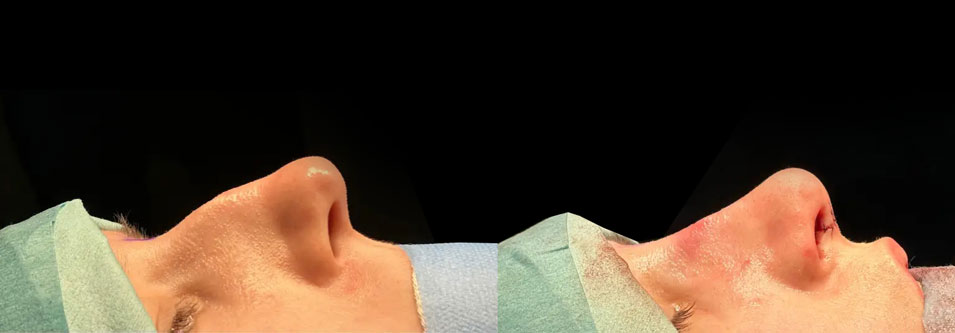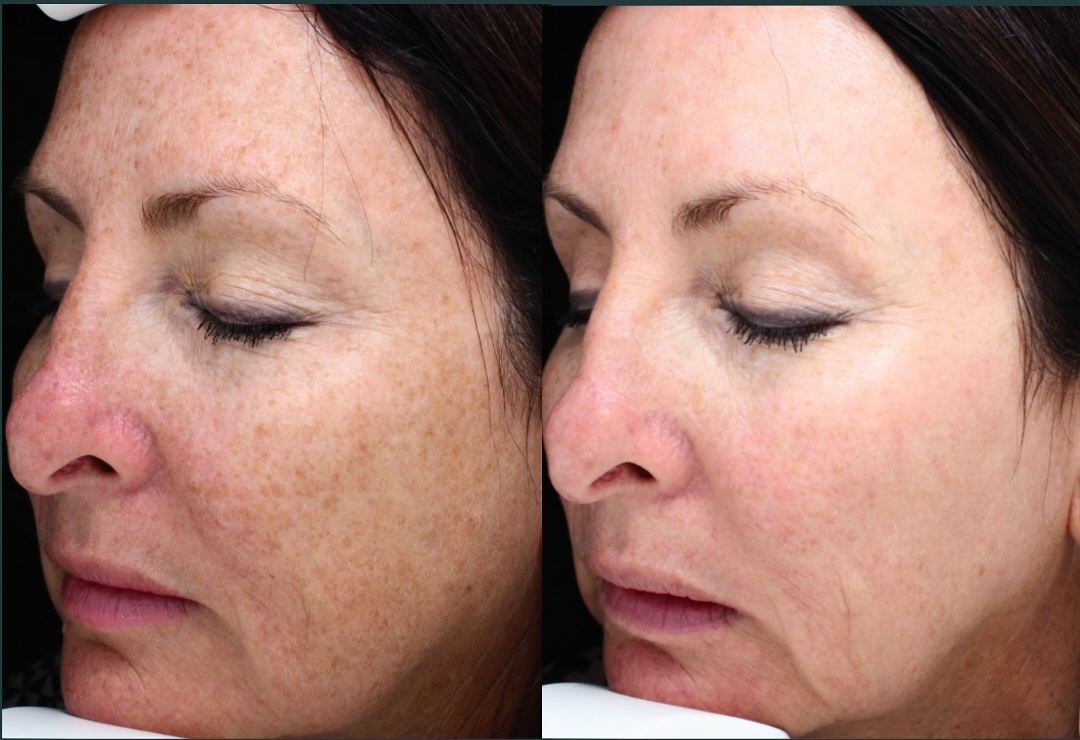What is Rhinoplasty Surgery
Rhinoplasty, often called a “nose job,” is a surgical procedure that reshapes or adjusts the size of the nose to improve both appearance and function. Many patients choose rhinoplasty to correct breathing difficulties, repair damage following trauma, or to find greater balance and symmetry across their facial features.
At Real Plastic Surgery, we provide the most advanced, bespoke rhinoplasty tailored to each of our patients. Whether your goal is to refine the shape of your nose, restore its structure following injury, or improve your breathing, Consultant Plastic Surgeon Mr Naveen Cavale and our team are here to deliver safe, natural-looking results with the highest standards of patient care. From consultation through recovery, our ethos and medical approach ensure you are fully supported and safe at every stage.
Benefits of Rhinoplasty Surgery
Rhinoplasty is one of the most sought-after procedures because it can deliver both cosmetic and functional improvements. It can refine the shape of the nose whilst also correcting structural problems that interfere with breathing. We find that many patients experience a significant boost in confidence and overall quality of life post-surgerytoo.
Key benefits include:
- Restoring facial symmetry or harmony by reshaping the nose to complement your features
- Improving breathing by correcting structural blockages, like a deviated septum
- Repairing damage caused by trauma or previous injury
- Improving self-confidence with a more balanced, natural appearance
What Are Your Options for Rhinoplasty with Mr Naveen Cavale?
The right approach to rhinoplasty will depend on what is bothering you, your anatomy, and your desired outcome. During your consultation, Mr Naveen Cavale the best rhinoplasty surgeons in London will talk you through the different techniques available and advise on which is best suited to your needs. Here are some rhinoplasty options you may want to explore:

Open Rhinoplasty
Open rhinoplasty involves a small incision across the columella (the strip of skin between the nostrils), with the incision extending around the nostril rims. This allows the skin to be gently lifted, giving the surgeon full visibility of the nasal structure. With this access, Mr Cavale can make precise adjustments to the cartilage and bone. Open rhinoplasty is often chosen for more complex cases or when significant reshaping is required.
Closed Rhinoplasty
Closed rhinoplasty is performed through incisions made entirely inside the nostrils, leaving no visible scarring. This technique offers less visibility of the nasal framework, so it requires significant surgical expertise. It is best suited to patients requiring moderate adjustments, such as refining the bridge or reshaping the tip, without the need for extensive reconstruction.
Septorhinoplasty
A septorhinoplasty combines both functional and cosmetic improvements. In this procedure, the nasal septum (the structure that divides the nostrils) is straightened to improve breathing, while aesthetic concerns such as shape, size, or symmetry can also be addressed. This approach is particularly beneficial for patients with a deviated septum or structural issues that cause nasal obstruction.
Tip Rhinoplasty
Tip rhinoplasty, sometimes called rhino-tip surgery, focuses solely on refining the nasal tip. By reshaping or repositioning the cartilage at the end of the nose, Mr Cavale can create a more refined, balanced look tailored to your facial features. This procedure is commonly performed to correct a bulbous, crooked, or drooping tip, or to reduce flared nostrils.
Ethnic Rhinoplasty
Patients of East Asian, African, or Middle Eastern heritage may have specific concerns, such as a flatter bridge or wider nostrils. In these cases, augmentation rhinoplasty may be performed to subtly raise the bridge using either grafts (taken from the patient’s rib, ear, or skull) or biocompatible implants. Nostril width can also be reduced through a procedure called alar base reduction, which involves removing a small wedge of tissue at the nostril base. Mr Cavale specialises in tailoring results to respect and preserve each patient’s unique features while achieving the desired refinement.
Septoplasty
A septoplasty is performed when the primary concern is functional rather than cosmetic. This procedure corrects a deviated septum to improve airflow and resolve issues such as nasal obstruction, snoring, or sleep apnoea. Septoplasty can also be combined with cosmetic rhinoplasty (as a septorhinoplasty), where both breathing and aesthetic improvements are required.
Alar Base Reduction (Alarplasty)
For patients concerned about wide or flared nostrils, alar base reduction reshapes the nostrils to achieve a more proportionate look. This can be performed as a standalone operation or in combination with other rhinoplasty techniques for a balanced, natural result.
Who is a Good Candidate?
Patients considering rhinoplasty need to be in good overall health and motivated by their own personal goals rather than external pressure. Mr Cavale offers multiple consultations at no additional fee to ensure you are fully comfortable and confident in your decision. You may be a suitable candidate if you:
- Are in good physical health, with no serious medical conditions
- Do not smoke, or are willing to stop before and after surgery
- Have realistic expectations about what rhinoplasty can achieve
- Wish to improve either the cosmetic appearance of your nose or functional breathing issues
- Have experienced previous trauma or injury to the nose, such as a broken nose.
A consultation at Real Plastic Surgery will provide a medical assessment of your suitability and help create a treatment plan that aligns with your goals and lifestyle.
The Rhinoplasty Procedure

Rhinoplasty is a highly specialised operation that requires both surgical precision and artistic judgement. At Real Plastic Surgery, Mr Cavale carefully plans his procedures and performs them to achieve results that look natural and balanced, so you still look like you.
The surgery involves general anaesthesia. Depending on your needs, either an open or closed approach will be used. During the procedure, Mr Cavale reshapes the bone, cartilage, and tissue using ultrasonic piezo technology to refine the nasal structure. Functional corrections, such as straightening a deviated septum, can also be made during the same procedure. The incisions are then closed with fine sutures, and a splint or dressing is applied to support healing.
Most operations take between 1.5 and 3 hours, though more complex or revision cases may take longer.
Recovery and Results
Initial swelling and bruising usually settle within two weeks, allowing most patients to return to light daily activities after about 7–10 days. While the majority of healing happens within the first month, it can take anywhere from six months to two years for subtle swelling to completely resolve and for the final shape of the nose to be visible.
Rhinoplasty offers permanent results, as the bone and cartilage are permanently reshaped. Natural ageing may cause slight changes over time, but the improvements achieved with surgery are long-lasting.
Suggested Read:
- 10 Essential Rhinoplasty Recovery Tips from Mr Naveen Cavale
- Septoplasty vs Rhinoplasty Surgery: Key Differences & Which Is Right for You
- Can Rhinoplasty Fix a Deviated Septum? Everything You Need to Know
Risks and Considerations
Like all surgical procedures, rhinoplasty carries potential risks. Choosing an experienced, board-certified surgeon like Mr Naveen Cavale significantly reduces these risks and ensures a safer, more predictable outcome. Read more about Mr Cavale here.
Possible risks include:
- Swelling and bruising
- Temporary numbness or tingling
- Mild discomfort or nasal congestion
- Breathing difficulties due to swelling or scarring
- Infection (rare)
- Unsatisfactory results, which may require revision surgery
Why Choose Real Plastic Surgery?
At Real Plastic Surgery, our approach to rhinoplasty combines surgical expertise with an eye for natural aesthetics. Under the care of Mr Naveen Cavale, who has over 20 years of experience and has operated on over 10,000 patients, you can expect:
- A tailored treatment plan designed for their unique goals
- Safe surgical techniques carried out in our accredited facilities at The REAL Clinic
- Natural, long-lasting results that enhance both function and appearance
- Comprehensive aftercare throughout the recovery process












Real stories of our patients.